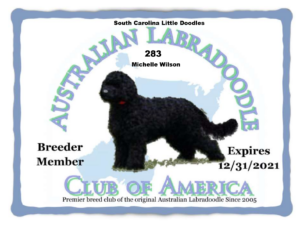The Breed
WHAT IS AN ORIGINAL AUSTRALIAN LABRADOODLE?
Click on the below link for a great article that explains how Australian Labradoodles are different from the others . . . . . . . . .
In the early days, the Australian Labradoodle was simply a cross between a Labrador Retriever and a Standard Poodle. Dogs from this cross typically were bred to each other over future generations, whereby the Australian dogs are also know as “Multi-generational” Labradoodles.
Then, in the late 1980’s, Tegan Park and Rutland Manor (established kennels in Australia), the two founders of the Australian Labradoodle as we know it today, began carefully infusing several other breeds into early generations of their Lab/Poodle crosses, to improve temperament, coat, conformation, and size. The infused breeds include Irish Water Spaniel as well as the American and English Cocker Spaniel. The resulting labradoodles subsequently have been bred to each other, continuing the multi-generational tradition.
Today, Australian Labradoodles are wonderful, intelligent dogs with lush coats that are more reliably low to non-shedding and allergy friendly than other types of Labradoodles such as first generation Lab/Poodle crosses, or first generation crosses bred back to Poodles. Even when the other types of Labradoodles are bred on for generations, the result is not an Australian Labradoodle, as the attributes of the infused breeds were not included in their ancestry.
Labradoodle variations are distinguished by their genetic comprise and therefore assorted traits, such as their temperament, coat type and physical conformation. Various breeds and Labrador Retriever to include the Irish Water Spaniel, Curly Coat Retreiver, and American or English Cocker Spaniel. These breeds have been carefully selected and limitedly infused into Australian Multigenerational Labradoodle bloodline originated in Australia in the breeding programs of Tegan Park and Rutland Manor.
Wool: This is very dense and curly like a poodle. A wool coat typically has more cotton-like feel. It can be kept long but requires more grooming in this style. If it is kept short this coat is easy to maintain and usually non-shedding and allergy friendly.
- MINI sized Labrdoodles range from 13 -16 inches tall and they are typically 15-25 lbs.
- MEDIUM sized Labdradoodles range from 17-20 inches tall and they are typically 25-45 lbs.
- STANDARD sized Labdradoodles range from 21-25 inches tall and they range from in weight from 50-65 lbs.
F1: The “F” stands for “filial generation”. “F1” means “first generation” and is a common scientific term. This, in the Labradoodle breed, is the coding for first-cross, purebred poodle to purebred Labrador Retriever. The results are mixed, as this is not the breeding of two “like” dogs, or dogs that resemble each other. F1 Labradoodles typically are moderate- to low- shedding and have a sparse-hair to fleece coat.
F1B: The additional “B” refers to backcross — an F1 Labradoodle, as defined above, bred (or backcrossed) to a purebred Poodle. Again, the results are mixed, as this is not the breeding of two “like” dogs. F1B Labradoodles typically are low- to non-shedding (or as much as any dog can be non-shedding) and often have a hair or fleece coat.
Australian Labradoodle: The Australian Labradoodle carries the DNA of the Labrador, Poodle, and Cocker Spaniel (American or English). The resulting offspring share characteristics, though some pairings of parent dogs will produce a more mixed litter. An Australian Labradoodle can be created by crossing a Poodle to another Australian Labradoodle, a Cockapoo to a Labradoodle, a Labradoodle to a Cocker Spaniel and the like, resulting in the three-breed combination.
Multigen Australian Labradoodle (Multigenerational): A Multigenerational (Multigen) Australian Labradoodle comes about from the breeding of one Australian Labradoodle to another. Multigen Australian Labradoodles typically have a non-shedding coat (as much as a dog can be non shedding) if both parents are also non shedding.
Purebred Australian Labradoodle: The Merriam-Webster Dictionary first defined “purebred” in 1852 as “bred from members of a recognized breed, strain, or kind without admixture of other blood over many generations.” The AKC, meanwhile, requires four generations of like-to-like matings in their foundation service.
The land Down Under used to be best known for kangaroos and boomerangs, but that was before the Australian Labradoodle wagged his tail onto the scene. This dinky pooch isn’t your average designer dog. In fact, he’s technically not a standard hybrid. He started off as a simple cross of a Labrador Retriever and a Poodle, but then the recipe got complicated. A dash of Irish Water Spaniel, a dollop of Curly Coated Retriever” (these two are no longer used and not in all pedigrees), “and a sprinkling of English and/or American Cocker Spaniels went into the mix. Now the breed has 3 worldwide clubs: The Australian Labradoodle Club of America (ALCA), the Australian Labradoodle Association of America (ALAA) and the Worldwide Australian Labradoodle Association (WALA) working to promote the Australian Labradoodle as a legitimate breed in development.
For more information about the breed and breed standards, please click on the picture below. It will direct you to the Australian Labradoodle Club of America where you will find a wealth of information on the Australian Labradoodle and the club standards.

